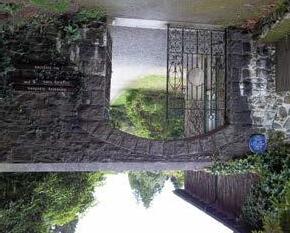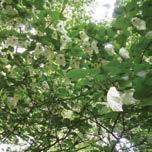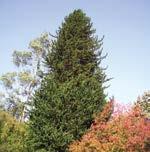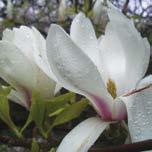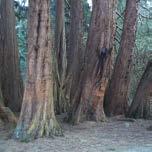champion trees which are largest or fattest known tree of a particular species.
different species of rare and tender plants from all over the world thriving in the hospitable climate at Castlewellan. Hugh Annesley wrote about the collection in his book, Beautiful and Rare Trees and Plants, published in 1903. The Collection has been added to in the intervening years through careful selection of plants by Forest Service staff. The 5 hectare garden is the hub of the Arboretum which now extends to some 45 hectares and contains an internationally important collection of trees and shrubs with many beautiful and rare species. The Arborteum also includes a significant number of
By the early 20th century there were over 3000
It was Hugh Annesley (1831–1908), 5th Earl, who was primarily responsible for the development of the Arboretum. Like many keen plantsmen of his time he sourced seeds and seedlings from around the world. Hugh built up the gardens, the bothy yard and a range of glass-houses, three vineries, and a cool conservatory; water was laid on in all the houses.
puzzle trees
(commonly known as the
exotic planting was associated with this pleasure ground; for example ten
both the old and new enclosed gardens. Considerable
The layout was regular with a long axis path linking
terracing to support a fine range of glasshouses built by Gray, of Chelsea, in 1869–70. The terracing was designed by William Burn in the late 1850s and built of granodiorite quarried locally at Ballymagreehan.
twelve acres in the 1850s with fountains and glasshouses, complete with fashionable Victorian-style
being transformed into a pleasure garden of around
Garden in tribute to the former owners. The garden started life in the 1740s as a kitchen garden before
The walled garden is now known as the Annesley
To aid bio-security we request you do not take cuttings or seeds.
Please respect the garden by sticking to the paths.
Some of them are also champion trees.
This trail will lead you through the main parts of the garden by highlighting 26 of the most interesting and significant trees and shrubs in the garden. These bring colour and interest at different times of the year.
The Tree Trail
Two years later the Forest Park was opened to the public by the Governor of Northern Ireland, Lord Grey of Naunton.
Castlewellan Forest Park is a demesne steeped in history and dates from medieval times. The development of the walled garden is due to the Annesley family who bought the Manor of Castlewellan in 1741 and over generations improved the lands and developed the Town. Over the next two centuries they planted thousands of trees and developed a unique Arboretum, with the walled garden as the central hub. In 1967, Gerald Annesley sold the demesne to the Ministry of Agriculture.
The Annesley Garden lies within Castlewellan Forest Park, situated north of the foothills of the Mourne Mountains in County Down, Northern Ireland. It is about 48km (30 miles) south of Belfast off the A24.
visitmournemountains.co.uk
IMAGE Davidia involucrata (Handkerchief tree)
This trail was written by Sam Harrison, Alwyn Sinnamond and Robert Trotter, with the assistance of Sally Montgomery.
The Tree Trail
The garden area is divided into two by a high wall, selectively screened by the planting of flowering trees and shrubs, and running from the entrance towards the greenhouses. It is further sub-divided by well planned paths, the main ones giving long straight vistas.
Looking from the centre of the garden, where the two main paths intersect, the focus of attention is the ornamental fountains.
The larger of the two, in the lower garden, is the Heron fountain with stone herons patiently standing guard. While the top fountain is called the Merboy fountain.
To start the trail, enter through the main gate and turn right. This will lead you to the lower garden, passing the 18th Century urns. This area has some of the oldest and tallest trees in the garden.
1 Drimys winteri
Just at the top of the steps is this South American tree from the temperate rain forests of Chile and Argentina. It flowers in May time with ivory white fragrant flowers. Its common name ‘winters bark’ reflects the fact that sailors in the past used an infusion of the bark to help to prevent scurvy.
2 Sequoiadendron giganteum
These two twin trees, on either side of the path are the giant redwoods from California, planted in 1856. They are likely to have been in the first batch of trees, released by the Veitch nurseries, grown from seeds brought back from North American in 1853 by the Cornish plant collector, William Lobb. NIG1
3 Davidia involucrate is the Pocket-handkerchief tree or dove tree from central and western China. It is a remarkable sight in late May when draped with its large white bracts. Pendulous solitary fruit pods follow in the autumn. NIh1
4 Juniperus recurva This is the Drooping juniper from the Eastern Himalayas. The wood of this species is burnt in Buddhist temples as incense. Ih2 NIh1
5 Sciadopitys verticillata
This living fossil is commonly known as the Japanese umbrella pine or parasol pine. NIG1
6 Podocarpus acutifolius, the Needle-leaf Totara from New Zealand. British Isles Champion tree. h1 G1
7 Thujopsis dolabrata [also called Hiba] is a sole member of its genus from Japan. It can be identified by the vivid white stomatal bands on the under surface of the leaf. The leaves have a distinctive thick, almost fleshy texture. EG
8 Eucryphia glutinosa
This is a deciduous shrub native to Chile, flowering profusely from July to August. In autumn the leaves have beautiful autumn tints. Hugh Annesley wrote about this plant in his book Beautiful and Rare Trees and Plants He said, “It bore a fine crop of seed pods in 1901 which it took 15 months to ripen”. It is the mother to the plants that make up the Eucryphia walk. Ih1 IG1
9 Abies numidica This Algerian fir is the oldest Abies in the garden and was planted in 1881.
10 XCuprocyparis leylandii ‘Castlewellan’ This is the original ‘Castlewellan Gold’ seedling from 1966, from which the first cultivars were propagated. h1 G1
11 Juniperus recurva ‘Castlewellan’ The cultivar ‘Castlewellan’ has branches like fishing rods. h1 G1
12 Parrotia persica is a sprawling specimen of the Persian witch hazel, which has a spectacular contorted trunk and branches, with the leaves providing brilliant autumn colour.
13 Pinus hartwegii is related to Pinus montezumae. It is an imposing tree with a domed crown and is native of Mexico / Central America. Ih1 IG1
14 Athrotaxus cupressoides is called the Pencil pine and is endemic to Tasmania. It is a slow growing, long lived tree. NIh1 NIG1
Note: It is the smaller tree in front of the large Abies nordmanniana subsp. equl-trojani the Turkish Fir.
15 Chamaecyparis lawsoniana ‘Wisselii’ is a vigorous slender conifer which has numerous very attractive male red strobili (which look like cones) in spring.
Walk past the greenhouses, go through the small arched opening and up the stone steps.
16 Magnolia dawsoniana from China has large pale pink flowers which bloom before the leaves come out.
17 Cercidiphyllum japonicum is called the Katsura tree and is found in Japan to China. It provides good autumn colour when the leaves turn yellow, orange and pink. As the leaves fall there is a smell like burnt sugar. NIh1
18 Nothofagus fusca is an evergreen southern beech commonly called Red beech and is a native of New Zealand. G1
19 Cephalotaxis harringtonia vat drupacea is native to Japan and its common name is Cow’s tail pine. It has plum like fruits.
20 Metasequoia glyptostroboides is called the Dawn redwood and it is a fast growing endangered species. It was originally only known from fossil records until it was found growing in central China in the 1940s. NIG1
21 Eucalyptus urnigera are striking trees, commonly called Urn gum, from Tasmnia. It has greyish, peeling bark and dark green leaves. G1
22 Banksia marginata is known as the Silver Banksia and grows throughout south-eastern Australia including Tasmania. It has distinctive yellow-green cone shaped flowers which grown brown as they age. It is said locally that it was planted by a relative of the famous botanist, Joseph Banks, which it is named after.
24
23 Pinus sylvestris ‘Aurea’ is the Golden Scots pine. It is a pea green colour for most of the year but during the winter months it is a spectacular sight particularly when its leaves turn a golden yellow.
NIh1
Neopanax laetus, a native of New Zealand, is a very handsome shrub with its dark green leaves and black fruits. Look down the hill to your right and you will see the British and Irish Champion.
25 Cornus capitata from the Himalayas, is a multi-stemmed species of dogwood. The flower heads in midsummer are surrounded by sulphuryellow bracts,to be succeeded in October by large strawberry-like fruits.
26 Sequoiadendron giganteum, this multi-stemmed giant redwood originating from California, was planted as one tree in 1856.


